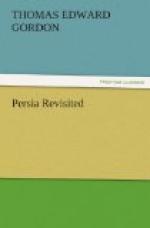The volcanic district of Afshar has long been known for its quicksilver, which from time to time has been found in small quantities. Some seven or eight hundred years ago Arab miners laboured long in their search for the main cinnabar vein which undoubtedly lies hidden there, and their wide workings in laying open a whole hillside, where signs of cinnabar are still seen, show what great gangs of labourers they must have had at their command. The Persian Mines Corporation in 1891-92 engaged in operations at the same point, but, after considerable sinking of shafts and driving of galleries into the heart of the hill, they decided to cease work, being disappointed, like their Arab predecessors, in not finding quickly what they had traced by clear signs up to its mountain source. A few miles below the site of these cinnabar-mine operations there are ancient gold-washing workings, and within thirty miles are heavy veins of quartz.
Tehran displays a marked advance in many of the resources of civilization; houses of an improved style are springing up, the roadways are better attended to, and there is a great increase in the number of carriages. The Prime Minister’s new house, near the British Legation, is situated in beautiful gardens, set off with pretty lakelets and terraced grounds, which give slopes for flowing waterfalls. These gardens, in common with all in the town, are tenanted every year by nightingales of sweet song. It is now proposed to enclose an adjoining available space to form a people’s park, which would be a great place of enjoyment in summer to a people of poetic imagination like the Persians, who delight in the green glade with the cool sound of flowing water. The severe cholera epidemic of 1892 showed the absolute necessity of an improvement in the rude sanitary system which then existed, and a beginning has been made in the daily careful cleaning of the streets and removal of refuse. But a better and increased water-supply is greatly needed for the town, which is becoming larger every year. People who have money to spend appear to be attracted more than ever to the capital. Those who before were content with the provincial towns now build houses in Tehran. The superior houses have garden-ground attached, and much tree-planting is done. The demand for water increases, but the supply is not supplemented. Years ago the




